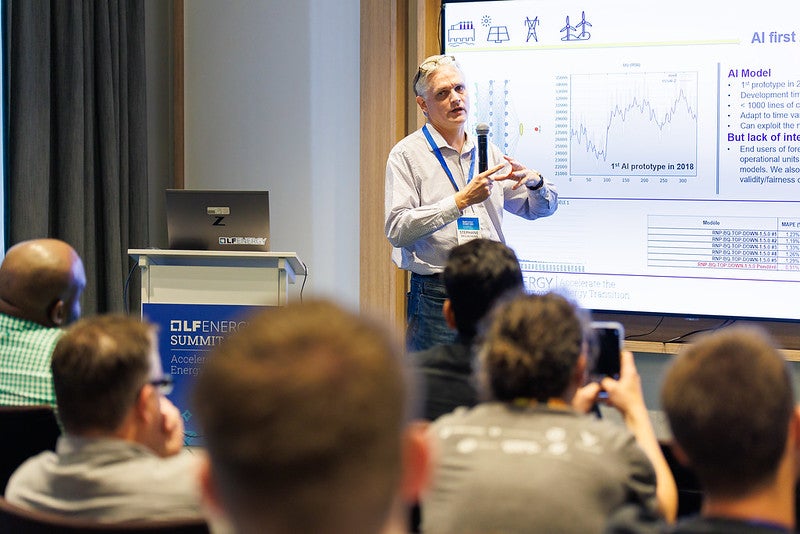LF Energy Summit Recap and Video: Machine Learning for Short-Term Demand Forecasting on the Quebec Power Grid
At LF Energy Summit 2024 in Brussels, Stéphane Dellacherie from Hydro-Quebec presented a session titled Machine Learning for Short-Term Demand Forecasting on the Quebec Power Grid. This session provided insights into the challenges and advancements in predicting energy demand, particularly in the context of Quebec’s grid, which is deeply impacted by weather and climate factors. Here’s a summary of the key points covered, with the full video available at the end.
Importance of Short-Term Load Forecasting
Forecasting energy demand accurately is crucial for the operation of power systems, encompassing transmission, generation, and distribution management. Hydro-Quebec, a leader in hydropower, faces unique challenges due to Quebec’s climate. The extreme weather variations between summer and winter cause significant fluctuations in demand. For instance, a temperature change of just one degree in Montreal can result in a change of 100 megawatts in energy demand. Similarly, wind speed and cloud cover also have substantial impacts on the grid’s load.
The Influence of Weather and Climate Change
Dellacherie illustrated how Quebec’s energy consumption is highly sensitive to meteorological conditions, describing a “banana curve” that tracks energy consumption relative to temperature. In winter, as temperatures drop, energy use surges due to heating, while in summer, it increases due to air conditioning. Moreover, climate change is amplifying this issue. The increase in extreme weather events is distorting the “banana curve,” leading to more unpredictable spikes in energy demand. These factors, combined with the shift towards renewable energy and the rise in electric vehicles, make load forecasting an even more complex task.
Hydro-Quebec’s Open Source Approach
Hydro-Quebec is embracing open source technologies to address the increasing challenges of load forecasting. Dellacherie emphasized the importance of collaboration across borders to tackle the energy transition. Hydro-Quebec is already leveraging tools like TensorFlow and PyTorch and is an active contributor to the open source community through partnerships with initiatives like LF Energy and CRAIM. The company has also developed a Julia-based package that solves complex non-linear problems, which they recently published in the Journal of Open Source Software.
The Short-Term Load Forecasting Library
One of the central tools discussed was Hydro-Quebec’s Short-Term Load Forecasting Library, which has been in development since 2019. This open source library integrates deep learning models, such as Temporal Convolutional Networks (TCN) and Transformer networks, to provide both deterministic and probabilistic forecasts. Dellacherie showcased its real-time results and explained how Hydro-Quebec is working to continually improve the accuracy and efficiency of its models in operational settings. One key focus has been reducing the time-to-market for deploying new forecasting models, which has been achieved through strategic collaboration between research and operational teams.
Deep Learning in Action: Real-Time Forecasting Results
One of the standout moments of the presentation was Dellacherie’s live demonstration of real-time forecasting results. Using deep learning models, Hydro-Quebec has significantly improved forecasting accuracy, reducing human intervention in the forecasting process by 95%. Dellacherie highlighted how these models performed during extreme weather events, such as a polar vortex, when temperatures plummeted to -40°C. Despite the challenge, the system managed to forecast demand spikes, allowing operators to make rapid adjustments.
Bottom-Up and Top-Down Forecasting
Hydro-Quebec’s forecasting strategy combines both bottom-up and top-down approaches. The bottom-up method aggregates data from individual consumers, while the top-down approach forecasts for the entire grid. This hybrid strategy allows the system to scale to large datasets and train hundreds of models in parallel. Dellacherie described future plans to introduce generative AI and further enhance their forecasting capabilities, especially in light of changing societal behaviors, such as teleworking and the rise of electric vehicles.
Continuous Improvement and Future Perspectives
The session concluded with an overview of how Hydro-Quebec’s continuous improvement cycle ensures that their forecasting models remain accurate and reliable. By training new models, running real-time experiments, and integrating feedback from operational teams, Hydro-Quebec is building a robust forecasting infrastructure. Dellacherie also shared his vision for long-term research, hinting at a possible future where AI could be used to develop even more advanced models that take into account geographic power densities, leading to further optimization of the grid.
